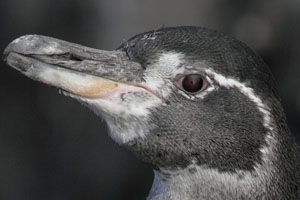Climate Change / ENSO Events
The greatest threat to the survival of the Galapagos Penguin is global warming. Galapagos Penguins are only able to exist around the equator due to the cold Equatorial Undercurrent (Cromwell Current) which flows eastwards through the Galapagos Archipelago and is forced upwards in the vicinity of Fernandina and Isabela Islands. El Nino Southern Oscillation (ENSO) events equally affect the upwelling of the Humboldt Current along the west coast of South America and the upwelling of the Cromwell Current at Galapagos. An increase in upwelling which may last for up to a year and causes high marine productivity generally precedes ENSO events due to strong southeast trade winds increasing circulation of the South Pacific subtropical gyre (Wyrtki 1975. J. Phys. Oceanogr. 5, p.572-584). However, upwelling is subsequently reduced to below normal levels, leading to high sea surface temperatures in the affected coastal waters and an associated decline in productivity. During intense ENSO events this may lead to severe mortality and breeding failure of seabird populations.
The Humboldt Penguin populations in Peru and Northern Chile suffer severely and the entire Galapagos Penguin population is threatened by such events. The magnitude of the problem has been illustrated by past ENSO events. On Fernandina, in 1971, 63 of 82 monitored nests successfully fledged at least one chick. This coincided with productive pre-ENSO conditions. However, during the ENSO event, breeding attempts in Dec. 1972 - Mar. 1973 and Aug. - Oct. 1973 resulted in a total of only one chick from 200 monitored nests (Boersma 1978. Science 200, p.1481-1483). The weight of adult birds was well below long-term average during the event and several starved adults were found weighing under 1.8 kg, although adult mortality was not extremely high (Boersma 1998. Condor 100, p.245-253). An even more severe ENSO event occurred in 1982-83 and led to huge adult mortality approximating to 77% of the pre-ENSO population (Valle and Coulter 1987. Condor 89, p.276-281). Recovery of the population after this event was slow. This can be attributed to the fact that since the 1980s, there has been a general trend to warmer water temperatures with few and weak El Nina events where water temperatures are lower and productivity is high (Boersma 1998. Condor 100, p.245-253). Thus, the population had not fully recovered when it was hit by a further extreme ENSO event in 1997-98 which reduced the remaining population by about 65%. Making matters worse, mortality of females was particularly high, leading to an excess of male birds which could not contribute to population recovery (Boersma 1998. Penguin Conserv. Nov. 98, p.10-11). In Humboldt Penguins, nest intrusion behaviour by unmated males resulted in several incidents of egg loss or chick mortality and was responsible for over 10% of breeding failure at a study colony (Taylor et al. 2001. Condor 103(1), p.162-165). If such behaviour also occurs in Galapagos Penguins, this could inhibit population recovery when there is a surplus of male birds.
The trends in the Galapagos Penguin population from 1970 to 2003 reveal that recovery following the steep ENSO-induced population declines continued to be slow into the 21st century (Vargas et al. 2005. Ibis 147, p.367-374). The census data, which is based on marking and resighting techniques involving subsequent extrapolation of the population size based on the proportion of marked birds amongst those birds resighted, can not provide exact figures, yet the population was estimated at 1350 individuals in 2003, compared to 4000 in 1971.
The Galapagos Penguin has survived ENSO events for many thousands of years. Several studies have addressed the past frequency of ENSO events by studying lake sediments. For example, the varying salinity of sedimentary strata in hypersaline Bainbridge Crater Lake on the Galapagos Islands was studied (Riedlinger et al. 2002 J. Paleolim. 27, p.1-27). Salinity falls during periods of heavy rainfall which are associated with ENSO events. The study concluded that ENSO events were present but infrequent between 6100 and 4000 yrs BP (before present), but occurred with increasing frequency and intensity in the last 4000 years. Significant fluctuations in frequency were observed with 152 moderate and 14 strong / very strong events from 2000-1000 BP (before present), but 5 moderate and 36 strong / very strong events in the last 1000 yrs. Another study analysed even older sediments in Laguna Pallcacocha in southern Ecuador (Rodbell et al. 1999. Science 283, p.516-519). Here, sediments were analysed on the basis of layers of material washed into the lake during periods of heavy rainfall. From 15000 to 7000 BP, periods of over 15 years separated periods of heavy rainfall. However, after this period, the frequency of events continually increased, reaching a periodicity of from 2 to 8.5 years by about 5000 BP. After this period, the long-term average frequency was considered similar to that seen at present.
The problem is that a relatively rapid increase in ENSO events has been recorded since the late 1960s (Trenberth and Hoar 1997. Geophys. Res. Lett. 34, p.3057-3060) and that there are fewer cool El Nina periods in between during which population levels can recover. Indeed, it appears that equatorial upwelling in general has been decreased by 25% after 1970, with an associated rise in mean sea temperatures of nearly 1'C (McPhaden and Zhang 2002. Nature 415, p.603-608).
The survival of the Galapagos Penguin has been modelled based on the continuation of the level and frequency of ENSO events measured in the period between 1964 and 2004 (Vargas et al. 2007. Biol. Conserv. 137, p.138-148). The model estimated a 30% chance of extinction within 100 years. If the frequency of strong ENSO events is doubled, the probability of extinction increases to 80%. Also, the model assumed a 1:1 sex ratio which is at least questionable, especially shortly after severe ENSO events. If the proportion of females is lower, as suggested by some authors, the outlook is even more bleak. Clearly, any further warming trend will reduce the penguins chances further by increasing mortality of adult and juvenile penguins, and by reducing the number of cool years when the population can recover. Most forecasts are presently pessimistic with regard to the issue of global warming, so it is possible that only captive populations will be able to survive in the foreseeable future (the author is presently not aware of the existence of captive populations).
Climatic warming may also be associated with increased wind-speeds and larger waves. Given that most nests are located within 2 m of sea-level, such waves may cause nest flooding. This has indeed been observed in 2004, when at least 4 nests were lost due to a particularly large wave (Vargas et al. 2006. Biol. Conserv. 127, p.107-114). Fishery activities around Galapagos are regulated, yet there is competition between commercial fisheries and penguins for sardines and mullets, which may exacerbate problems during ENSO years. Further, penguins are known to drown after getting caught in nets deployed to catch Mullet or Sharks.
Disease
A major potential threat to the population is also considered to be the introduction of disease, and this may exacerbate the population decline resulting from climatic factors. Galapagos Penguins are immunologically relatively naive. Studies have shown that the birds are seronegative for a wide variety of avian viruses, whilst most have antibodies to Chlamydophila psittaci which is generally asymptomatic in penguins. However, occasional outbreaks of highly virulent strains in captive penguins have been reported (Travis et al. 2006. J. Wildlife Dis. 42(3), p.625-632). Further, due to the small population size and associated levels of inbreeding, variation in the genes of the immune system is very low in the MHC loci which are instrumental in disease resistance (Bollmer et al. 2007. Immunogenet. 59, p.593-602). In general, the Galapagos Penguin has exceedingly low genetic diversity compared to the similar Magellanic or Humboldt Penguins and the population is homogenous in the sense that no subpopulations can be defined based on genetic analysis (Akst et al. 2002. Conserv. Genet. 3, p.375-383; Nims et al. 2008. Conserv. Genet. 9, p.1413-1420). The lack of diversity or subpopulation structure means that the whole population may be ill-equipped if presented with a new pathogen. Further, since the populations at different sites evidently mix, the probability of disease transmission between populations is high.
Human settlement and associated introduction of livestock or parasites bear the risks of exposing the penguins to new diseases. The mosquito Culex quinquefasciatus was first reported on the eastern islands of the Galapagos group in 1989 and has since then established itself and spread to other Islands (Whiteman et al. 2005. Ibis 147, p.843-847). This mosquito has the potential to carry avian malaria and West Nile Virus, in contrast to the native mosquito. Avian Malaria is a major threat to Spheniscus populations in general and can cause over 50% mortality in previously unexposed zoo populations (Cranfield et al. 1991. Sphenisc. Peng. Newslett. 4, p.5-7). It is implicated in the decline of many native forest birds in Hawaii following its introduction (Van Riper 1988. Ecol. Monographs 58, p.111-127).
Penguin blood samples taken in 1996 did not reveal evidence for avian malaria or the avian Herpesvirus Marek's Disease Virus (MDV), which had shortly before caused significant mortality in a Galapagos poultry farm (Miller et al. 2000. Mar. Ornithol. 29, p.43-46). MDV may not be able to infect penguins due to its limited host range, yet continued monitoring is required. Unfortunately, recent research analysing blood samples taken in 2003-2005 has revealed that avian malaria was now already established itself in the Galapagos Penguin population (Levin et al. 2009. Biological Conservation 142, p.3191-3195). Analysis of samples, as in the previous study, involved use of highly sensitive PCR technology which can detect the presence of even minute amounts of Malaria parasite (Plasmodium) DNA. The sequences recovered from the penguins showed little diversity, suggesting that they have recently arrived and had little time to differentiate. Further, they reveal similarity to the species Plasmodium elongatum which is known to cause acute and sometimes fatal infection in penguins. During 2003-2005, levels of Plasmodium infection fluctuated from 3-7% between different sampling periods. There was no obvious upward trend. Infected penguins were detected at various sites on Fernandina, Isabela, Santiago and Bartolome, so essentially the whole range is already affected. No obvious detrimental effects on health were evident and 2 infected birds were recaptured after over half a year. A major concern is how infection will affect penguins when these are weakened by other factors, such as ENSO events. This remains to be established. Further, the development or arrival of a highly virulent strain is a constant threat.
The transmission of disease from poultry is of increasing concern in view of the recent increase in back-yard or large commercial poultry operations on the Galapagos Islands. These provide food for the increasing population and tourist numbers. Seropositivity was found for a number of pathogens in Galapagos chicken stocks during 2001-2003, including Infectious Bursal Disease, Mycoplasma galliseptum, Avian Adenovirus Type I, Marek's Disease, Avian Encephalomyelitis, Infectious Bronchitis Virus and Newcastle Disease Virus (Gottdenker et al. 2005. Biol. Conserv. 126, p.429-439). Many of these are probably endemic in the population, although only few samples seropositive for Newcastle Disease Virus (Avian Paramyxovirus-1) were found, which is a known major threat to penguins. Disease may pass from poultry to wild bird populations via waste and run-off water from poultry farms but also via interaction between humans or wild animals and poultry that can easily occur in often disease-ridden back yard chicken operations.
Pigeons are also regarded as potential transmission sources for avian pathogens and are being actively eradicated (Phillips et al. 2003. Notic. de Galapagos 62, p.6-11).
Infections with parasites such as Filarid nematodes are common in the penguin population but are generally considered subclinical or non-pathogenic. Nevertheless, the emergence of new parasites needs to be monitored. Males were preferentially parasitized in the Galapagos Penguins examined, yet no link between parasite load and body mass could be determined (Merkel et al. 2007. J. Parasitol. 93(3), p.495-503). Dirofilaria immitis can probably cause fatality in penguins and is present on Isabela, yet was not detected in the penguins. The chicken populations studied by Gottdenker et al. also had a number of nematode species and thus could be a source of infections.
Predation
Predation is not considered to pose a major threat at present. Observations suggest that adults or juveniles suffer occasional predation by Galapagos Hawks (Buteo galapagoensis) on land and by Sharks at sea. It is conceivable that owls could also prey on penguins, as well as Fur Seals, Sea Lions and Orcas, which are known to occasionally prey on other penguin species. Predation by feral house cats and dogs is an increasing problem since human settlements have grown in size in recent years. Rats, Snakes and Crabs may take young or eggs, yet these have generally been deserted beforehand. In fact, only a small percent of even deserted eggs disappear.
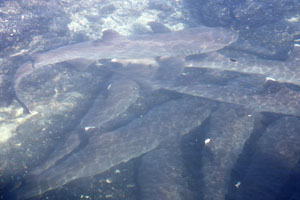 |
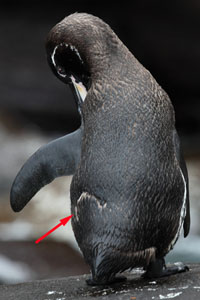 |
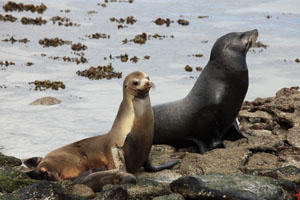 |
|
White-tipped Reef Sharks
|
Scar from bite
|
Galapagos Sea Lions
|
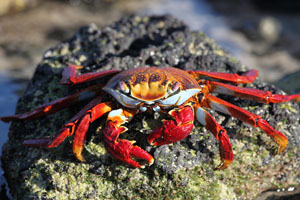 |
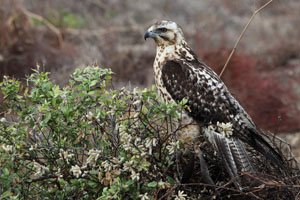 |
|
Sally Lightfoot Crab, most common crab on Galapagos
|
Galapagos Hawk
|
Volcanic Activity
Volcanic activity may also locally affect penguin populations. During the 1979 eruption of Cerro Azul on Isabela, lava reached the sea and caused an increase in the water temperature at Bahia Elizabeth. It has been suggested that this may have negatively affected penguins at this locality (Harcourt 1980. see Valle and Coulter 1987. Condor 89, p.276-281). However, whilst this may cause some disruption, it is unlikely to cause significant fatalities. Recent volcanism has generally been of a diffusive and relatively benign nature on Galapagos and since the Islands have been formed entirely by volcanic processes, the Galapagos Penguin actually owes its existence to these.
Impact of Tourism
The direct threat caused by tourism is difficult to ascertain. Whilst regulated tourism may have little direct impact on the penguins, rules have often been ignored in the past (De Groot 1983. Biol. Conserv. 26, p.291-300). The situation in this respect seems to be better now. However, the development of touristic infrastructure and need to sustain large numbers of tourists (see e.g. chicken farm issue) has an impact on the Galapagos environment. Further, the economic benefits of tourism have drawn more people to the islands and the local population continues to rise, with all of the problems generally associated with population growth in environmentally sensitive areas. About 27,000 people live on Galapagos and approx. 100,000 tourists visit annually (Boersma et al., 2005. Science 308, p.925). Many building sites around the periphery of the towns are testimony to the continuing population growth.
|
